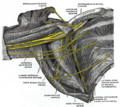Thoracodorsal nerve
| Thoracodorsal nerve | |
|---|---|
 Plan of brachial plexus. (Label for thoracodorsal nerve at bottom center.) | |
 Latissimus dorsi | |
| Details | |
| From | Posterior cord (C6-C8) |
| Innervates | Latissimus dorsi muscle |
| Identifiers | |
| Latin | nervus thoracodorsalis |
| TA98 | A14.2.03.016 |
| TA2 | 6430 |
| FMA | 65290 |
| Anatomical terms of neuroanatomy | |
The thoracodorsal nerve is a nerve present in humans and other animals, also known as the middle subscapular nerve or the long subscapular nerve. It supplies the latissimus dorsi muscle.[1][2]
Anatomy
Origin
The thoracodorsal nerve arises from the
Course
It passes inferior-ward anterior to the
It follows the course of the subscapular artery, along the posterior wall of the axilla to the latissimus dorsi muscle,[1] in which it may be traced as far as the lower border of the muscle.[citation needed]
Distribution
The thoracodorsal nerve innervates the latissimus dorsi muscle on its deep surface.[1]
Clinical significance
The latissimus dorsi is occasionally used for transplantation, and for augmentation of systole in cardiac failure. In these cases, the nerve supply is preserved, and transplanted with the muscle (for example, with facial reanimation).[6]
Posterior cord lesions can result in the loss of adduction of the shoulder joint, as innervation to latissimus dorsi is lost.[3]
Additional images
This gallery of anatomic features needs cleanup to abide by the medical manual of style. ; please improve or remove the gallery accordingly. (June 2015) |
-
Brachial plexus
-
The right brachial plexus (infraclavicular portion) in the axillary fossa; viewed from below and in front.
-
Brachial plexus with courses of spinal nerves shown
References
![]() This article incorporates text in the public domain from page 934 of the 20th edition of Gray's Anatomy (1918)
This article incorporates text in the public domain from page 934 of the 20th edition of Gray's Anatomy (1918)
- ^ ISBN 978-0-12-410390-0, retrieved 2020-11-01
- ISBN 978-0-323-02899-8, retrieved 2020-11-01
- ^ ISBN 978-1-4557-2672-1, retrieved 2020-11-01
- ISBN 978-0-7506-7332-7, retrieved 2020-11-01
- ^ "thoracodorsal nerve - Dictionnaire médical de l'Académie de Médecine". www.academie-medecine.fr. Retrieved 2024-08-12.
- ISBN 978-0-12-803062-2, retrieved 2020-11-01
External links
- Dissection Video of Superficial Back showing the Thoracodorsal Nerve
- Anatomy figure: 05:03-10 at Human Anatomy Online, SUNY Downstate Medical Center - "The major subdivisions and terminal nerves of the brachial plexus."
- Thoracodorsal Nerve - BlueLink Anatomy - University of Michigan Medical School

